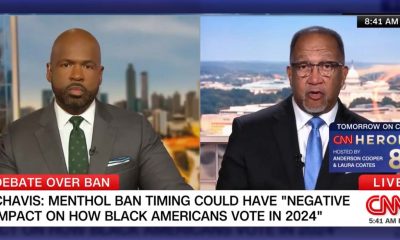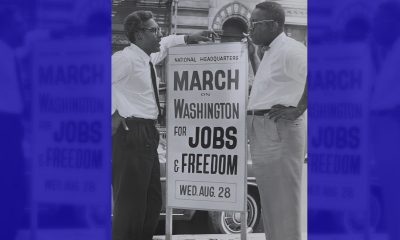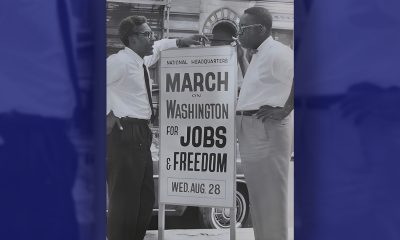National
For the Sake of Michael Brown


The family of Michael Brown leave a message on the street where he was gunned down by a Ferguson police officer on Saturday. (Wiley Price/St. Louis American)
Special to the NNPA from the St. Louis American
(NNPA) – With deep humility, we admit we did not see this coming, and not where it came – in a ring suburb, rather than in the city – though we can see where it came from.
North St. Louis County and many of its municipalities have suffered decades of economic disinvestment, loss of manufacturing jobs and disruption by highway construction and airport expansion. Those who chose to stay in these ring suburbs, or who had no other options, had to live – or die – with the consequences.
White flight, particularly to St. Charles County, first hit the school districts, then the tax base. Remaining homeowners are heavily taxed in areas with often struggling schools, little industry and dwindling businesses and services. The mortgage bubble really burst in these areas, with rampant home foreclosures. Large retail areas in North County have been abandoned. Small businesses face difficulty establishing a presence due to high prices for retail space and insurance costs. Those who stay charge more, and those who buy from them pay more.
When businesses and retail move, those who remain have to spend their money with establishments elsewhere in the region. That builds up the tax base in other areas, not their own. For those who lack reliable transportation (let alone job skills and education), there are few opportunities to eke out a livelihood locally. There is little escape.
Disillusionment, resentment and tension set in where economic opportunities, recreation and thriving businesses once flourished. The “look at us, we are on our way back” slogans boasted by chambers of commerce say nothing about those who have been treated as invisible or dispensable.
As for our youth, many of them may not be properly educated, but they are not stupid, and it is not difficult for them to hear what they are being told in the cold language of unaccredited districts and transfer students. Michael Brown graduated in the much-discussed Normandy School District, an unaccredited school district that expired not long before he was killed. He and his peers – specifically, those strivers willing to transfer to a better school district – were told they were not wanted by many other districts in the region, once those districts were no longer required to accept them.
It may take a village to raise a child, but many administrators and parents in better-resourced parts of our region had no problem saying quite publicly that Michael Brown and his brothers and sisters did not belong in their village.
So it is not difficult to understand the frustration and anger of the sons and daughters of these disinvested ring suburbs. It is even easier to understand why, when their frustration and anger turned to rage at the murder of one of their own by a cop, it was directed at the police.
Most obviously, a police officer killed Michael Brown – in cold blood, according to eyewitnesses. But our sons’ and daughters’ rage at the police started long before Michael Brown and his friend were told to get out of the street on Saturday afternoon by a foul-mouthed Ferguson cop.
In many North County municipalities, it seems police run contests to see how many young black men you can pull over, flaunting the officers’ power and the motorists’ powerlessness. Our young men especially are regularly inconvenienced and humiliated while simply trying to get where they are going. The Missouri Attorney General annually releases a report, which no black person needs to read, that documents appalling disparities in how often black drivers are pulled over and searched, compared to white people, all over the state and the region.
But Michael Brown was not pulled over while driving. He was told to get out of the street while walking. For offering what was initially, according to an eyewitness, the mildest of resistance to a rude and unnecessary police order, this unarmed teen was shot in the middle of the day, and his bullet-riddled body left by police to lay in the street for hours, as if to provide a grisly example.
That did it. That’s what drove people (not just young people) to act out their pent-up rage. That’s what drove people to demonstrate (which is within their rights). That’s what drove people to the candlelight vigil on Sunday. And that’s what drove a few who disregarded the greater good to lash out at what was in front of them. The resulting chaos created an opportunity for looters – many of them, according to reported arrests, not from the immediate area – to smash and grab from what businesses remain.
We can’t bring Michael Brown back. But we can insist on a prompt, credible, transparent investigation – under the leadership of the U.S. Department of Justice, we urge – and that his killer be brought to justice. The officer should receive the constitutionally guaranteed due process he did not give to his victim. When his name is finally disclosed – as should have been done immediately – there must be no effort to bring him to the vigilante justice we see too often delivered from behind the authority of a badge.
We also must insist – as a life-or-death matter essential to the peace and functioning of our society – on an immediate and thorough review of police policy, procedure and training throughout the region. There are successful models of police/community cooperation that can be adopted. We must diversify our police departments – the Ferguson Police Department reportedly has three black cops in a staff of 53. We must train police officers who patrol minority neighborhoods in how to better understand the people on their beats and interact with them in a spirit of mutual respect. And we must stop protecting police officers when they use unwarranted force, against black men or anyone.
In the meantime, our angry youth and many supportive citizens remain on the streets, taunting police in riot gear with snipers sprawled on what amount to tanks, training high-powered rifles on unarmed black people with their hands in the air, chanting, “Don’t shoot!” among other things we won’t print.
We commend St. Louis Alderman Antonio French, state Sen. Maria Chappelle-Nadal and community activist and writer Tef Poe, in particular, for showing leadership on the streets in these tense days. It is clear, now more than ever, that many more of us need to leave our offices, churches and comfort zones and engage more directly with our angry and misdirected youth.
“We as leaders can help redirect their justified anger,” French tweeted in the heat of the battle. “But we can’t do it from churches or our living rooms. We have to be with them.”
It should also be painfully clear, now more than ever, that this is not a black problem, but a problem for our entire region and others like it across the nation. True, if our community were more organized and voted its strength, then municipalities like Ferguson would not have the utterly inadequate mayors and police chiefs that are making life-or-death decisions today – and making them very badly, with fatal consequences.
But these consequences have regional impact. In countless editorials, we have urged our corporate and political leaders to do more to include African Americans in educational, economic and social opportunities for the greater good of the region. Over and over, we have exhorted, our region cannot thrive when we consign so many of our youth to the oblivion of failing schools and poor job skills. Now, more than ever, it is clear that our region needs to do more to include African Americans from the earliest ages for the region not only to thrive, but simply to function peaceably.
We believe it is because not nearly enough capable people with resources in this region have heeded our plea that we have reached this crisis point of complete breakdown, when the St. Louis region has entered the world’s spotlight, not as one of its great places to live and work, but as one of its war zones. We need peace. But first, we need justice and equity, so that Michael Brown’s death is not wasted, like so many young black lives before his, and with them the future prospects of this region and nation.









































